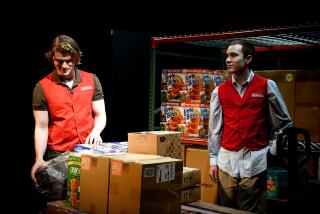‘Appaloosa’s’ ramrod
- Share via
GALISTEO, N.M. — AUTHENTIC westerns feature authentic dirt -- muddy chaps, weather-beaten storefronts and hair that’s far from blow-dry clean. But the dust storms that occasionally raged during the making of “Appaloosa” took actor-director Ed Harris’ old-fashioned gunslinger story from the realm of the genuine into the domain of the wind tunnel.
On a cool afternoon last October, Harris’ filmmaking team was battling the dermabrasion elements as the director raced a quickly setting sun. Electricians hid behind goggles. Carpenters covered their mouths with surgical masks. A handful of the crew donned welders’ visors. And pretty much everyone would spend a long time in the shower that night, trying to wash the fine grit out.
In addition to directing and co-writing the movie, Harris was playing Virgil Cole, who with partner Everett Hitch (Viggo Mortensen) has taken charge of the frontier town of Appaloosa in an unspecified Southwestern state to defend it from the ruthless rancher Randall Bragg (Jeremy Irons) and his malevolent gang. Toward the film’s end, the habitually law-abiding Hitch decides he must use some extrajudicial tactics to square up accounts and prepares for a gunfight in front of the town’s hotel.
As the scene unfolded, Mortensen stood rock solid, waiting to draw his Colt .45. And then his hat went flying away, a Frisbee on steroids. Harris reset the scene, and then cinematographer Dean Semler (“Dances With Wolves”) ran out of film. “That’s why I like to shoot digitally,” he muttered to Harris.
As the light was rapidly failing, Mortensen walked into the frame again, and once more his hat sailed off. Mortensen cursed under his breath, and Harris said, “Screw it, let’s do it again.”
With the hat at last refusing to take wing and Hitch’s victim dispatched, Mortensen (despite lots of equine work from “The Lord of the Rings” and “Hidalgo”) in consecutive takes struggled to reload his gun, untie his horse and climb into his saddle.
“It’s OK, take your time,” Harris told Mortensen, although he knew the clock was ticking, as the sun hurried toward the horizon. “OK, we’ve got 30 seconds to get this right,” Harris said coolly.
And as he spoke, the wind suddenly died down, Mortensen’s hat, bullets and stirrups finally cooperated, and Hitch rode off into the sun-dappled distance. “Wow, that was nice,” said Renée Zellweger, who plays Cole’s love interest, Allison French. “Look at that man ride!”
‘Things haven’t changed’
For ALL of its faithfulness to the western genre -- for instance, the production found the right locomotive in Arkansas and brought it to New Mexico -- “Appaloosa” carries a pedigree with little relation to cattle drives and saloons.
The film, opening Sept. 19, is adapted from a novel by Robert B. Parker, a crime writer famous not for westerns but for the Spenser detective series. Harris’ only other directing job, 2000’s “Pollock,” was a biographical drama about a troubled abstract painter. And “Appaloosa’s” financiers, Groundswell Productions (“The Visitor,” the upcoming “Milk”) and New Line Cinema (“Rush Hour,” “Austin Powers”), are respectively better known for contemporary dramas and high-concept crowd-pleasers.
But Harris, who adapted Parker’s book with Robert Knott, says the “Appaloosa” story is deceptively current, even though the action unfolds in the 1880s.
In a change from Parker’s book (there’s now a sequel novel), Harris and Knott made the villain Bragg more modern monopolist than old-fashioned robber baron; he’s sort of a Wall Street raider in spurs.
It’s particularly noteworthy, Harris says, that when Bragg ends up in legal trouble, he is able to call in a favor from Washington and get out of jail -- presidential pardons are a lot older than Bill Clinton and George W. Bush.
“To me, it’s amazing that things haven’t changed in 125 years,” Harris says during a break in filming “Appaloosa” on the Old West street set built for 1985’s “Silverado” that’s now part of fashion designer Tom Ford’s massive New Mexico ranch.
What attracted Harris to the novel -- and what Warner Bros. is banking on to market the film -- is the core relationship between Hitch and Cole. They have been together for years, work brilliantly as a team, but are willing to make sacrifices for the other’s happiness.
“If Hitch and Cole have a problem, they deal with it,” Harris says. “There’s a lot of subtext, a lot of things that are not said.” Adds Knott: “The movie is not sentimental. We don’t apologize for the characters’ behavior.”
If “Appaloosa” is ultimately a modern buddy movie trapped in a landscape filled with horses and cows, the film’s earliest potential backers didn’t see it that way. “Nobody was willing to give us the money we needed -- they run through their numbers and say, ‘We can’t sell westerns,’ ” Harris says. “It felt like eternity trying to get it set up.”
But unlike “Pollock,” for which Harris had limited resources and had to help pay for its production out of his own pocket (“On the second day of filming, I knew I was in trouble,” Harris says of his Oscar-winning film about the painter), the director had enough means from New Line and Groundswell to make the movie he wanted. “Although it’s certainly not extravagant,” he says of the $20-million budget.
Indeed, about the only thing excessive on the film was the wind. And when the time came, even it stepped into line.
--
More to Read
Only good movies
Get the Indie Focus newsletter, Mark Olsen's weekly guide to the world of cinema.
You may occasionally receive promotional content from the Los Angeles Times.











